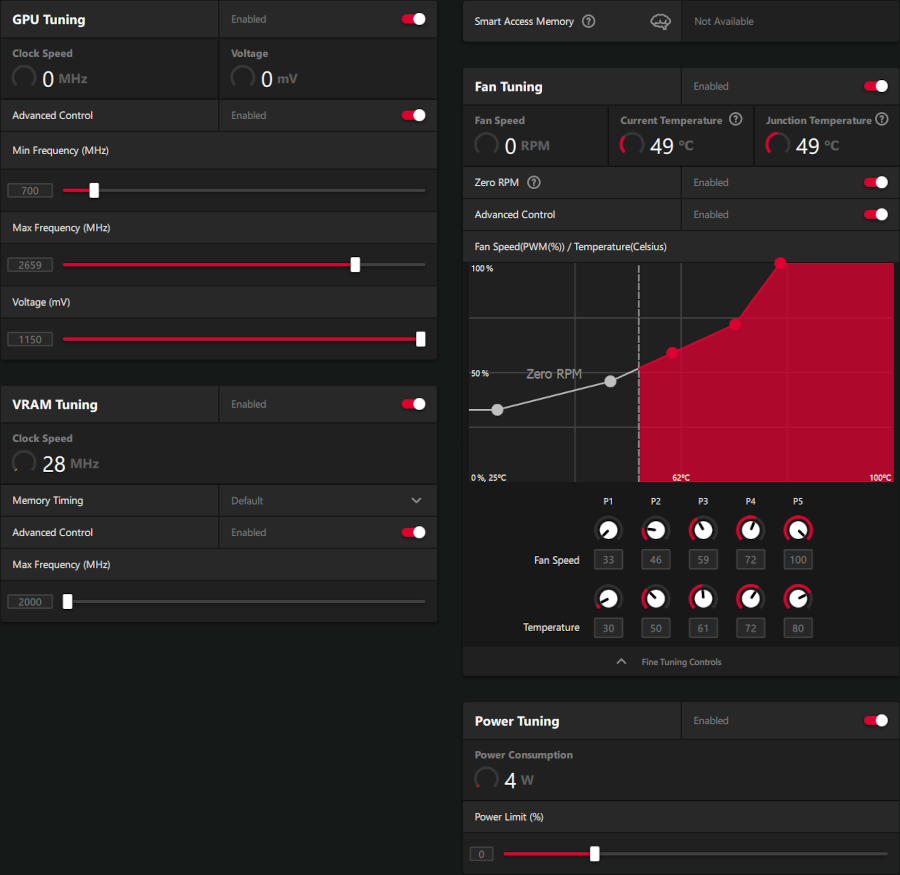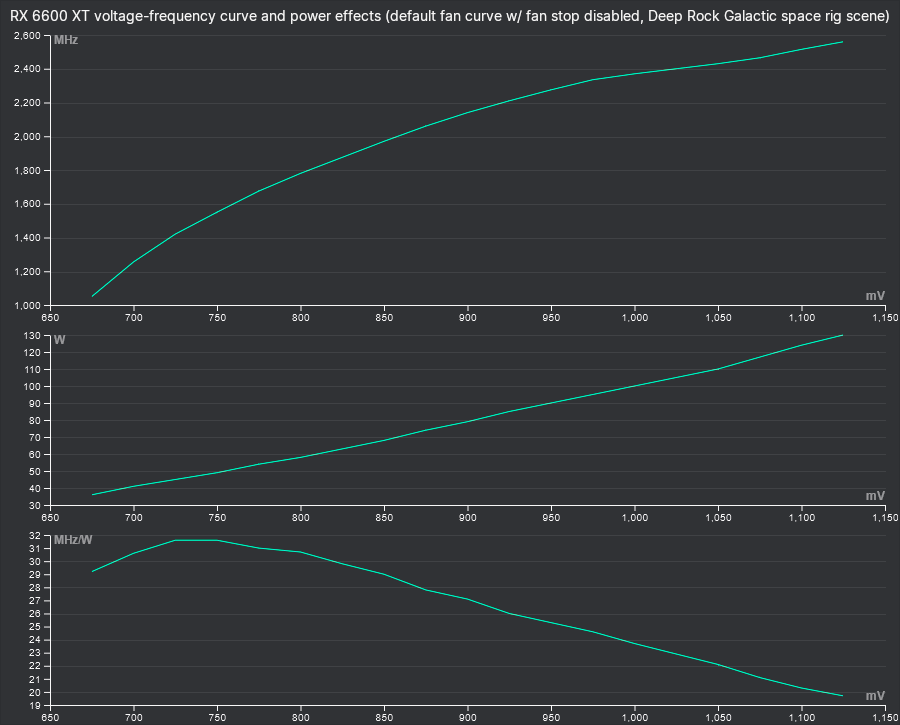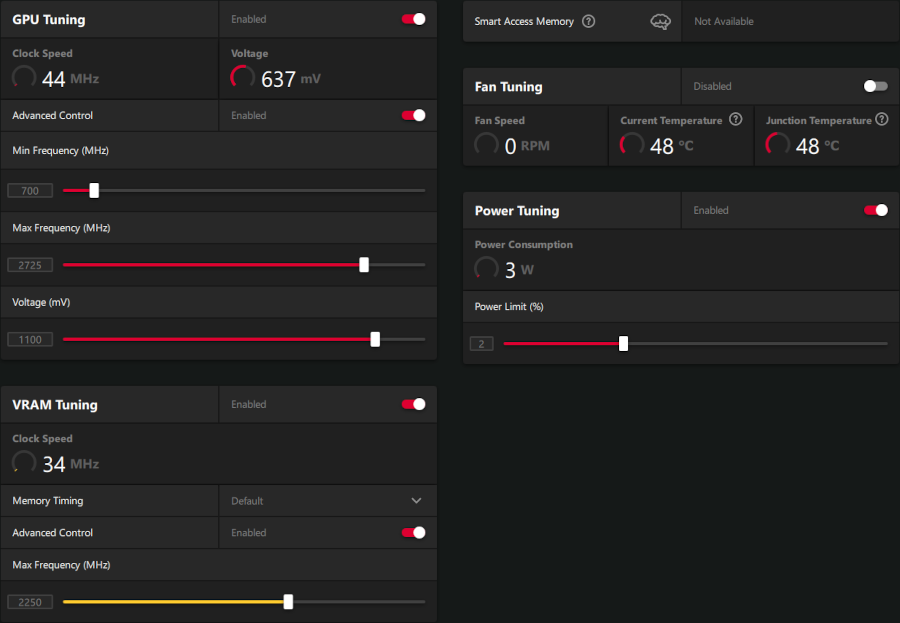Overclocking the Radeon RX 6600 XT
AMD’s overclocking tools in Radeon Software for this generation are more straightforward than before, and they’re relatively easy to get a solid tune with. Curve editing is missing now, but given how iffy it was last generation, that’s arguably not much of a loss. The baked-in curve is decent.
A few more things are missing for the 6600 XT:
-
You can’t raise the core voltage above default or lower the VRAM clock below default. There’s little reason to do this on a card in good condition, but it can keep dying cards usable much longer than they otherwise would be.
-
There’s no way to get more than 1150mV Vcore, and the power limit maxes out at +20%. These low limits should keep it fairly safe to mess around with, but those aiming for heavier overclocks may be disappointed by the lack of headroom.
-
The power limit can only be set as low as -6%, leaving reduced maximum clock as the main way to reduce power use.
One less tangible thing has improved about the experience: overclocking-related crashes have all been quick and painless to recover from with the 6600 XT. It sorts itself out quickly, comes back in a clean state, and you just restart your stability test and dial in your settings and you’re back in business. When using a stability test that boots quickly, you can iterate on a tune much faster than used to be possible.
The one bug I’ve run into in this area is that sometimes new settings need an alt-tab to the workload to apply properly.
Remember that overclocking isn’t risk-free or guaranteed, and don’t do it if you’re not comfortable taking on that risk.

Voltage
Think of this setting as a negative offset, not an absolute value. The default of 1150mV is also the card’s voltage cap of 1150mV, but when you lower the voltage the cap stays at 1150mV.
This is the setting that buys you both efficiency and speed at expense of stability. Less voltage means higher frequency within the same power budget.
Before being certain a voltage is good, stability test it at a variety of frequencies, including the highest it will run at and something much lower than normal (like 1800 MHz). It may not be possible to control the shape of the voltage curve, but we still have to worry about that shape — it won’t be a perfect match for what the chip can handle, and some frequencies will be able to handle more voltage offset than others.
My card can tolerate this down to roughly 1087mV before getting unstable (but can go down to more like 1037mV at certain frequencies). I didn’t see any clock stretching when testing this, but it’s worth watching for (it might be stable at a low voltage but lose performance from it).
Maximum frequency
Maximum frequency puts a cap on how far up its voltage-frequency curve it can go, so reducing it reduces voltage to match and increasing it increases voltage to match. There’s one exception: voltage is capped at 1150mV no matter what, so it isn’t possible to damage the card this way but may still be possible to make the card unstable just by increasing the frequency alone.
If this is set higher than the power limit lets the frequency go, then it has no effect.
The actual frequency tops out 30 to 70 MHz below the set maximum frequency in most scenarios, even at low maximum frequencies where it’s clear that nothing else should bind it.
Reducing the maximum frequency in small steps lets us map out the voltage-frequency curve AMD is using (this is probably a bit different for each card):

If you want to reduce power use, it might be more effective to aim for knees in the curve. This doesn’t have very sharp ones, but if one were useful 2335 MHz would be it (so maximum frequency set to ~2385 MHz to reach 2335 MHz actual). This happens at the same frequency regardless of how you’ve set voltage (but might not happen at the same frequency on your card as on mine).
The VRAM overhead means the efficiency gains available from underclocking are a bit smaller than I expected. This barely matters in a desktop context, but it’s more important when the same chip gets put in a laptop.
Minimum frequency
If it can’t meet this minimum within the power limit, it’ll clock stretch to fall under the power limit. This doesn’t show up on frequency monitoring, it’s just missing performance. It’s a lot of missing performance compared to having a lower minimum frequency, but it isn’t stuttery.
I see two main uses for this:
-
It could be used to keep frequency higher when CPU-bound for better latency.
-
It could be used to avoid less stable frequencies and enable more aggressive voltage settings.
Either one probably needs it set to well over 2000 to work correctly, at which point it draws noticeably more power under light loads.
Power limit
This is the setting with the most potential to damage your card. The maximum allowed of +20% is a conservative choice by AMD, but nonetheless, be a bit careful around this one. Don’t use large increases if you’re not fairly sure your card’s voltage regulators are good for it, and keep an eye on GPU junction temperature.
Without other tweaks, this lets you bias the card slightly towards performance or efficiency, but isn’t very effective.
During the process of overclocking, you’ll probably want to boost this so that you can better see the effects of other settings.
With the rest of a tune dialed in, wherever you’re comfortable with setting this is good.
Memory clock and timing
My card’s VRAM goes to about 2270, or 2230 with the tightened timings. 2290 with baseline timings drops back to the default 2000 performance and power draw, and 2250 with tightened timings is unstable.
When overclocked to 2250 it draws about 3W more than at default settings (or when the card is power-limited, draws 3W that would otherwise go towards core clocks, so a power limit of +2% roughly compensates for it).
This might give larger performance gains for the 6600 XT than elsewhere due to the 6600 XT’s combination of less baseline memory bandwidth and a smaller L3 cache, especially if you’re using it above 1080p. I’ll test more along these lines next.
Results
This has got a decent amount of stability margin on my card (but may or may not on yours), shouldn’t pose any particular reliability hazards (but as always don’t count on this), doesn’t do anything more advanced that would take longer to tune, typically draws less than 3 additional watts, and is good for +5-7% typical GPU-bound performance.
